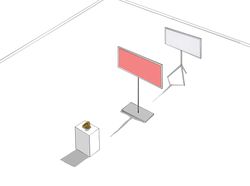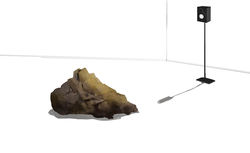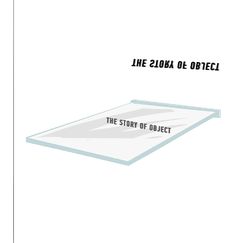Final
Cihad Caner
Story of objects that surround us
Introduction
Last year my self-directed research at Piet Zwart revolved around the varied topics, production of the space, identity and objects memory. Following the thematic seminar with Florian Cramer (An Encyclopedia of Media Objects), my emphasis turned into the tension between objects and how we perceive objects around us and their qualities.
During my research for the graduation show, I would like to investigate the following questions: what kind of relations there are between different objects, what kind of relations exist between human and non-human (objects, nature, etc.) what is the role of environment on perceiving objects. Sum total, I would like to focus on non-human agents.
I want this research to be visualized through one of the mediums such as light, sound, and/or text. I don’t have just one project proposal; there are three options for me to focus on. Because I also don’t want to work on these subjects only for the graduation show, I want to proceed on these topics in my future practice.
A
Light installation
I am interested in the visibility of the objects. Light helps us to comprehend objects, by making objects visible or invisible.
Light installation will consist of white LED light, PVC color filters (red, yellow, green, blue) and an object. In this light installation I want to change the existing color of objects through color filters and the object will appear in different color. For instance, if red light reflects on a green object, it appears yellow. This is a color subtraction. This work will try to make up relations between objects and exchanges of perspectives which engage the viewer in visualizing the potential for transformation of the phenomena will perceive.
Examples of object that I can work with, are;
Objects from my daily encounters (rocks, plants); Objects from Syria that I've collected two years ago for a project. I can reproduce some of them again with various materials.
B
Sound installation
Perceiving things is more about seeing, but listening is also interesting for me and how sound can effect your senses, therefore I would like to use sound in my work.
The sound installation will be that visitors can make sound by touching objects. Normally, when you touch the object in your daily life you don't expect to hear a sound or a reaction. As you encounter interaction with objects, it directly changes your perception on phenomenal objects. At that point, the object appears as something else, in viewers mind.
C
Text
Naming objects and making taxonomy is also a way of perceiving objects, it is the medium where objects are becoming physical on the paper or getting visualization in the mind.
I am planning to work with a mirror on the wall and a sentence or a word, which has been written reverse. Mirrors reflect everything reverse that is in front of it. Thus, in order to read the written text, the visitors need to look at the mirror that will be placed under this reverse writing.
Background
I will try to summarize my previous projects in order to elaborate my proposal.
The environment is one of the parameter that shapes our life. For the Root project, I started to travel to my village to know its people and the environment. I believe we shape the environment and at the same time the environment shapes us. I collected minerals and stones and used photography and video at the beginning of the Root project to document the relationship between my roots and me. The relationship that I want to build up was not working at the beginning through my lens. Photographs and videos were not enough to tell my experiences and stories. At that point, I decided to build up a space for the viewer to experience my relation with my roots. The idea of building up a space or production of space comes from Lefebvre’s book “The Production of the Space”. By using the concept of “representations of space”, I created a dark room full of soil and a photograph in a light box. The installation turned into a representation of my village where visitors could experience, a disconnected relation to my roots. In the installation, the earth is colder than the ambient temperature and the light box gave off ‘heat’.
The other part of my Root project is a reproduction of my origin. At the end of this project I realized that my village is no longer my root. My father and me were born in Istanbul, not in this village. As a result of this project this village is just a beginning of my origin. To define my roots, and myself, I chose natural objects (different kind of stones, minerals), which say more about my roots. I took the stones and minerals that I collected from my village as a starting point and started to reproduce them in different ways such as Resin, 3d mapping and reflections in a three sided mirror. In appearance reproduced stones are the same but they are totally different from each other internally. And during this project, working with stones helped me to establish understanding non-human language, to build up non-hierarchical relationship in this anthropocentric contemporary world.
Circle is a four channel, 49 minutes sound installation. It is the last result of my research on idea of Lefebvre's Production of Space. It makes a circle around you in order to effect your senses in a darkened room. It opens an abstract space where you can have a direct relationship with the artwork. The abstract space created by sound, tries to breakdown that powerful effect across the gallery space. It affects your sense of hearing and seeing. The produced space starts to suggest new emotions. The sound I produced refers to “designed space”, the sound refers to “lived space” and suggested emotions refer to “space that we make sense ” using the triad of Lefebvre. The dialectical relationship between these three spaces make a product of space like a circle.
Non Hierarchical Democracy is a 2.40 minute, one channel sound installation and consists of a speaker and stairs. There is a hoarse (speaking) sound. To hear the sound visitors need to step on a wooden stair and get closer. In the sound installation, you listen to a text from Bruno Latour. And also sounds produced by objects and human that visitors cannot distinct from each other.
Relation to larger context and my thesis intention
Recently, I have been reading a number of post-humanist philosophers –such as Bruno Latour, Tristan Garcia, Heidegger, Lefebvre, Bachelard, Imam Ghazali, Graham Harman all of whom counter the humanist tradition from Kant. This approach is in opposition to Idealism, which emphasizes presence and is human-mind centered.
The word Anthropocentric means that human privilege in the world, the human oriented world where the human is regarded as supreme species. But we are not the only ones who live in this world where everything is connected. I believe we shape our environment (habitat, objects around us, nature) and at the same time our environment shapes us.
"To balance our accounts of society, we simply have to turn our exclusive attention away from humans and look also at non-humans" (objects in my case) says Bruno Latour. And I believe we need to find a place for non-human masses in order to develop a social theory in our time. Previous years, I was making work about my origin and telling my story through objects (stones, minerals, soil, mirrors). I believe everything is relational that’s why I have picked these type of objects in order to talk about myself. I want to proceed this research by trying to find answers and turning my answers to art projects.
In the book of Graham Harman, The Third Table that was written for Documenta 13. He talks about finding the third table. Sir Arthur Eddington says, "There are two type of tables in our room". The first table is physical that we can touch and see which has four legs and wood. The second one is the scientific table, which consisted of atoms and electrons. But Harman says there is a third table, the real table that is not reducible and is not accessible.
Object oriented ontology is looking for the third table. Objects cannot be paraphrase according to Harman. For example a poem cannot be paraphrased like a poet means, all these descriptions will not fully express what initially is expressed in the poem. Poem is more than a description. There is no direct possible knowledge of objects and we can never translate objects perfectly to another language. There are two kinds of objects, Real objects and Sensual objects and their qualities. Real objects cannot be reducible and accessible, real qualities are also hidden from us. Sensual objects, sensual qualities are accessible and reducible by other objects. For instance, when a fire burns cotton it does not make contact to all properties of cotton. When we hold the cotton we aren’t touching whole cotton. Fire may not be alive and consciousness, however fire is just touching the certain features of the cotton just to its qualities. So, the fire is just touching the Sensual object and its qualities, fire cannot damage, reduce the Real object and its qualities. In art context there is an attempt to establish objects deeper than the features they are announced.
The Production of Space is a book from Henri Lefebvre. In his book he says that there are three type of spaces Spatial Practice, Representation of Space and Representational Space. I am interested in the representation of space and it is conceptualized space, the space of scientists, planners, urbanists, technocratic subdivides and social engineers whom identify what is lived and what is perceived with what is conceived and is the dominant space in any society (or mode of production). Representational space on the other hand is space as directly lived through its associated images and symbols, and hence the space of ‘inhabitants’ and ‘users'.
Practical Steps
I think I need to keep continue to build up a better knowledge of theory and of philosophical ideas to help explore and frame my thinking of objects, space and how we relate to each other. I will continue to my readings.
I need to make some prototypes on basic level just to experience with my mediums. Because sometimes, results don’t reflect my idea about the project. As a starting point, I am going buy white LED light. I am going to collect objects from my daily life and environment like natural objects or artifacts and will try to bring stuff that I collected in Syria. I will buy a 32x32 led light and some colorful photo filters. For sound option I can work with touching sensors, which can react on touching. I need to try out sensors.
References;
Books.
Lefebvre, Henri. Production of the space
Bachelard, Gaston. The poetic of space
Caryle, Angus. Lane, Cathy. (2013). On listening. Uniform books
Harman, Graham. (2010) The quadruple object. Zero Books
Harman, Graham. (2010). Towards to speculative realism. Zero Books
Harman, Graham. (2011). The third table. Hatje Cantz
Articles
Maridet, Cedric. (2006). Pierre Schaeffer and theory of sound objects.
McCluhan, Marshall. (1964). The Medium is the message
Guattari, Felix. Towards a post-media era
Foucault, Michel. The order of things
Latour, Bruno. (1998) To modernize or to ecologize? That’s the question
Latour, Bruno. Where Are the Missing Masses? The Sociology of a Few Mundane Artifacts’’
Harman, Graham. (2010) Time, space, essence and Eidos: A new theory of Causation
Serres, Michel. Natural Contract
Latour, Bruno. (2015). Fifty shades of green
Macit, Muhittin. (1997). Metaphysics of possibility: Critique of Ghazali’s determinism
The real thing: Art and Speculative Realism. (2010)
Hayles, Katherine. (2014). Speculative Aesthetic and object-oriented inquiry (ooi)
Mirror metaphors in Mantikut Tayr. (2012)
Sterne, Johanatan. Sound Studies
Nuur, Navid. (2015). Mining Memory
Internet Lectures
What is an object by Graham Harman, https://www.youtube.com/watch?v=9eiv-rQw1lc
On Metaphysics and Art by Graham Harman, https://www.youtube.com/watch?v=ck-fRgNUOAs
The Anthropocene and the Destruction of the image of the globe by Bruno Latour, https://www.youtube.com/watch?v=4-l6FQN4P1c
Ecological crises, Digital humanities and new political assemblies by Bruno Latour, https://www.youtube.com/watch?v=ylY1GRDNOB8



